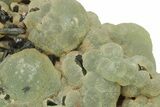9.9" Botryoidal Prehnite and Epidote - Mali
This is a 9.9" wide association of translucent, botryoidal green prehnite with dark-green epidote, collected from the Kayes Region of Mali, Africa.
About Prehnite
Prehnite is a translucent to transparent mineral typically ranging in color from pale green to yellow-green, though it can also appear white, gray, or colorless. It often forms in botryoidal, globular, or crystalline habits and has a vitreous to pearly luster. Prehnite is a calcium aluminum silicate hydroxide and is commonly associated with zeolites in the cavities of volcanic rocks. It has a Mohs hardness of 6 to 6.5 and is found in locations worldwide, including South Africa, Australia, China, and the United States.
Prehnite is a translucent to transparent mineral typically ranging in color from pale green to yellow-green, though it can also appear white, gray, or colorless. It often forms in botryoidal, globular, or crystalline habits and has a vitreous to pearly luster. Prehnite is a calcium aluminum silicate hydroxide and is commonly associated with zeolites in the cavities of volcanic rocks. It has a Mohs hardness of 6 to 6.5 and is found in locations worldwide, including South Africa, Australia, China, and the United States.
About Epidote
Epidote is a striking and often green mineral known for its complex crystal structure and vitreous luster. It is a calcium aluminum iron silicate that commonly forms in metamorphic rocks, particularly in regions that have undergone low to medium-grade metamorphism. The color of epidote typically ranges from pistachio green to dark green, although it can occasionally appear yellowish-green or even brown due to varying iron content.
Epidote crystals can appear in prismatic, slender forms or as aggregates, and they often exhibit striations along their length. The mineral’s translucent to transparent appearance and high refractive index give it an attractive, glassy shine.
It is commonly associated with minerals such as quartz, feldspar, and garnet, often forming in metamorphic rocks like schist and gneiss. It can also be found in skarn deposits alongside minerals like calcite, diopside, and amphiboles. These associations can provide insights into the geologic history and metamorphic conditions of the region. Epidote is found in locations worldwide, with notable sources including Austria, Norway, Pakistan, and parts of the United States. Collectors prize epidote for its unique green hues and well-formed crystal clusters.
Epidote is a striking and often green mineral known for its complex crystal structure and vitreous luster. It is a calcium aluminum iron silicate that commonly forms in metamorphic rocks, particularly in regions that have undergone low to medium-grade metamorphism. The color of epidote typically ranges from pistachio green to dark green, although it can occasionally appear yellowish-green or even brown due to varying iron content.
Epidote crystals can appear in prismatic, slender forms or as aggregates, and they often exhibit striations along their length. The mineral’s translucent to transparent appearance and high refractive index give it an attractive, glassy shine.
It is commonly associated with minerals such as quartz, feldspar, and garnet, often forming in metamorphic rocks like schist and gneiss. It can also be found in skarn deposits alongside minerals like calcite, diopside, and amphiboles. These associations can provide insights into the geologic history and metamorphic conditions of the region. Epidote is found in locations worldwide, with notable sources including Austria, Norway, Pakistan, and parts of the United States. Collectors prize epidote for its unique green hues and well-formed crystal clusters.
$495
SPECIES
Prehnite & Epidote
LOCATION
Kayes Region, Mali, Africa
SIZE
9.9 x 6.2"
CATEGORY
ITEM
#219544
 Reviews
Reviews

















